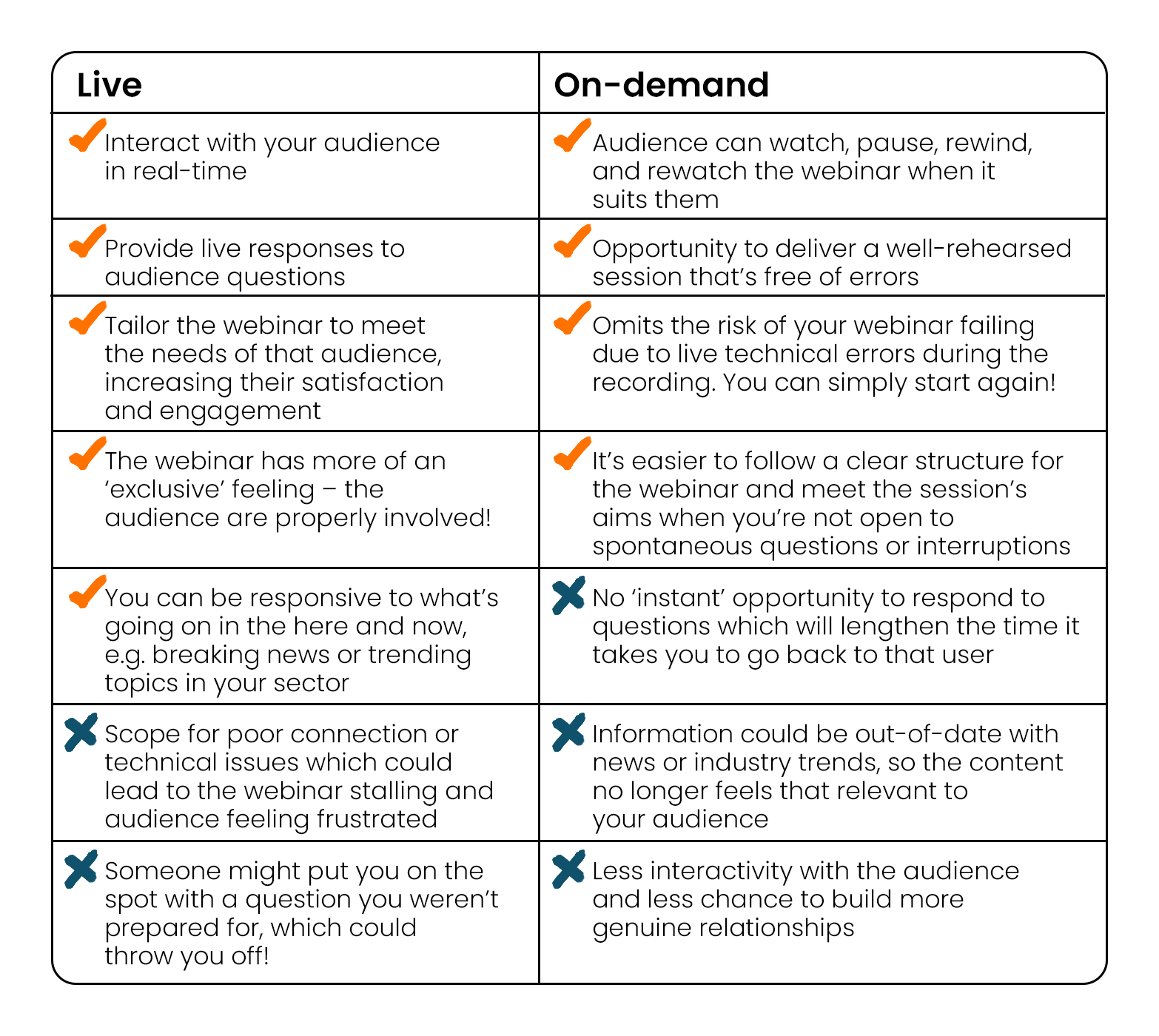B2B Webinar Strategy Guide: Webinar Logistics
B2B Webinar Strategy Guide: Part 2
Welcome to part 2 of our B2B webinar strategy guide, focussing on B2B webinar logistics.
(Missed part 1? Catch up here!)
Once you’ve decided who your webinar is targeting and what you’re going to be talking about, it’s time to think about when it’s going to run – and how your audience will access it.
Read on to find out what’s involved in running B2B webinars, including:
- How long a webinar should be
- Live VS on-demand webinars
- How to promote your B2B webinar!
When should you run a B2B webinar?
Tuesdays and Wednesdays are largely agreed to be the best days of the week to run a ‘live’ webinar, and for good reason. You’ve not got the Monday chaos that comes with the start of the week, or the rush to wrap things up on a Friday!
Mid-morning also tends to be the most suitable time for attendees to join a webinar. As a rule, we’d recommend your webinar starts and finishes between 10am and 12pm. It gives your audience time to mull over what you’ve been speaking about through lunch and then put into action during the afternoon shift!
WebinarsWebinar logistics: How long should a B2B webinar be?
Like with anything, it depends on the nature of what you’re looking to discuss. Generally, 30 to 60 minutes tends to be the preferred amount of time to spend on a webinar – from both an attendee and host perspective.
Any more than that and you risk putting people off before they’ve even signed up – diaries are too busy to allow for more than an hour! But any less, and you risk limiting or rushing through what you’re trying to share, which could leave your audience dissatisfied.
Having relevant information driving your webinar is key to retaining your audience’s attention, with pockets of value-added tips, tricks, and insight to keep them hooked on your every word!
Live VS on-demand webinars
Given that most webinars run during the day whilst we’re in the working environment (and usually sat at a desk), it’s unsurprising that more than 9 in 10 of people prefer to watch webinars on a desktop. It’s up to you whether you run webinars as live or pre-recorded sessions, or if you do a bit of both!
Most webinar hosting platforms let you record the live session for you to then share, be it with the webinar’s attendees or your team (to support internal training). On-demand webinars are rising in popularity thanks to their accessibility – they can largely be accessed from anywhere, at any time, without the constraint of having to be somewhere at a certain time.
But real-time sessions have their advantages, too – especially as they allow for you to tailor your webinar to be more reactive to your audience’s needs. We’ve rounded up the pros and cons to the webinar logistics of both types of session below!

On-demand B2B webinars
On the whole, we’d recommended that making any webinar you run available on-demand would be an asset to your business, be it once you’ve ran it live or pre-recorded it.
When your audience are given the freedom to choose not only what they’d like watch, but when, you’re increasing the value of the webinar recording to them.
They’re more likely to commit to engaging with the session and getting more from it, rather than feeling rushed to join a ‘live’ webinar whilst they’ve got urgent email after email flooding their inbox on their second screen!
Did you know…
“You can make the on-demand asset more of a lead-generator. By email-gating its download, you can better understand who’s wanting to access your content, the sector they’re in, and the role and business they’re working for!
You might spot a pattern in the sizes of business or types of roles downloading the webinar, insight you can then put to good use to make the topics of your next webinars targeted to this audience’s needs.”
Gabrielle, Content Lead at Halston B2B
How to promote a B2B webinar
So you’ve decided to run a live session, but how are you best to promote it? B2B webinars can be marketed in multiple ways across multiple channels, like:
- Sharing the events in your regular email marketing campaigns
- Posting about them on your brand’s social media accounts
- Hosting your full webinar schedule (and on-demand sessions) on a dedicated website page
- Spreading the word – quite literally – on calls, during meetings, and at events
- Using paid media (like PR advertorials, e-shots, or social ads) to reach a wider audience
Remember, one of the principles of best webinar practice is tailoring the content to meet the needs of your audience. The same goes for how and where you promote it, too!
Client insight
We conceptualise and coordinate all the management for Every By IRIS, our EdTech client that runs webinars on a frequent basis to spread awareness of their education HR, compliance management, and payroll products.
Regular reviews of their webinar promotion data led us to find that the closer to the date their live webinar is happening, the more likely we are to generate higher registration (and attendance rates). That’s compared to sending out promotional communications well in advance (say, a month), which usually then require another reminder.
Case Study: Every By IRISIndustry statistics
Industry stats support our findings:
- 26% of people sign up to a webinar more than 15 days in advance
- 43% sign up 1 to 7 days in advance
- 10% will even sign up on the day of!
You’re now ready to nail your brand’s webinar logistics, so what’s next? It’s time to focus on the main event: delivery of your B2B webinar. Click below to read the third and final part of our B2B webinar strategy guide!
